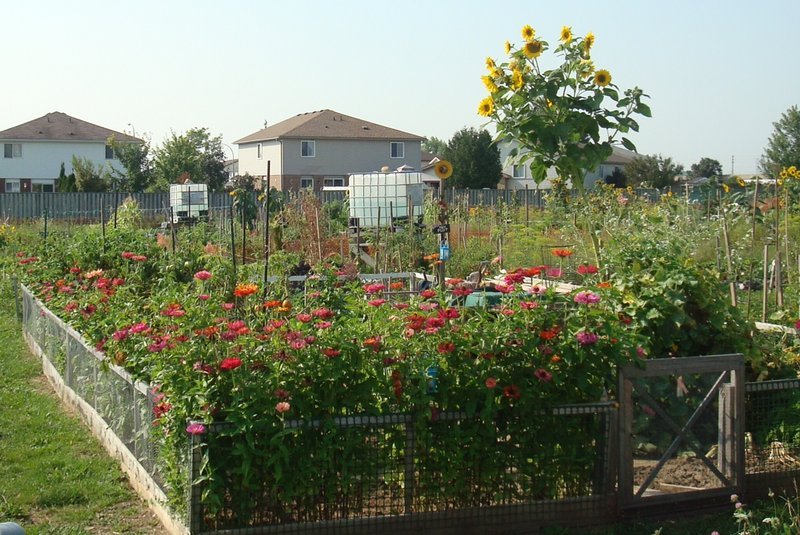Back to October 2015 Newsletter
Hummingbirds Love the Pollinator Fedge

Kim Fellows
Just a few weeks ago, I was delighted to see a hummingbird whiz into John and Vera Plut's dahlia patch. The Plut's plot is part of the Hope and Unity Community Garden in Kitchener, Ontario, at which we are establishing a 'Pollinator Fedge'. See our August 2015 article.
The ruby-throated hummingbird has a range across Canada that extends from Alberta eastwards to the maritimes. British Columbia has the good fortune to host the black-chinned, Calliope, and Rufous hummingbirds. Most of these species will migrate south to Mexico and Central America.
Apparently, hovering like a helicopter over flowers for long durations is a feat unique to hummers, amongst birds. They eat more than half their weight each day, in both nectar (providing them with carbohydrates) and insects (for protein). So while they clearly need a lot of energy, I wonder if hummingbird feeders actually serve them well?
Perhaps a climbing vine such as red honeysuckle (Lonicera dioica) or purple clematis (Clematis occidentalis) might be grown in place of the hanging feeder for viewing pleasure? No need to throw out your feeders, as you could choose to simply use them as a source of water, refreshing it regularly.
Below is a list of native plants beloved by hummingbirds. We encourage the use of native plants because they have co-evolved with the hummers, and they are best adapted to local growing seasons, climate and soil. Hummingbirds are especially attracted to big, tubular, red flowers, but also orange and white flowers. The list below is not complete, and may not be applicable across the country. Please use a database such as the North American Native Plant Society or your own favourite, to check a plant's suitability or search for other nutritious hummingbird plants.
As always, if purchasing from a non-organic source, ask if pesticides were used to grow the plant.
Hummingbird Flowers
Agastache foeniculum (Giant Hyssop)
Asclepias tuberosa (Butterfly Weed)
Penstemon digitalis (White Beardtongue)
Delphinium glaucum (Pale Larkspur)
Chamerion angustifolium (Fireweed)
Monarda fistulosa (Wild Bergamot)
Aquilegia canadensis (Wild Columbine)
Lilium philadelphicum (Wood Lily)
Ribes aureum (Golden Currant)
Eupatorium maculatum (Joe-Pye Weed)
Liatris spicata (Dense Blazing Star)
Lobelia cardinalis (Red Cardinal Flower)
Lupinus polyphyllus (Bigleaf Lupine)
REFERENCES:
Attracting Hummingbirds to Your Garden Using Native Plants, United States Department of Agriculture, April 2015.
http://www.fs.fed.us/wildflowers/pollinators/documents/animals/AttractingHummingbirds.pdf
Putting your garden to bed for the winter? Please see our bulletin article 'Pollinators and Your Winter Garden'.
**
Kim Fellows is the coordinator of Pollination Canada
Photo: Kim Fellows -- A hummingbird was sighted in John and Vera Plut's dahlia patch at the Hope and Unity Community Garden in suburban Kitchener, Ontario.
Not yet a member?
An annual membership to Seeds of Diversity gives you access to our seed exchange, seed grow-out programs, and our online news.

We depend on donations to do our work.

Thank you for your support!
